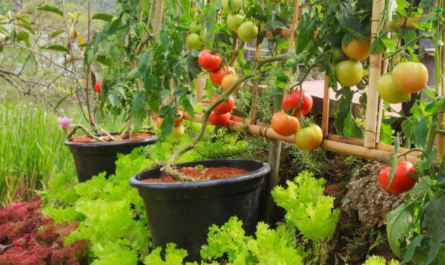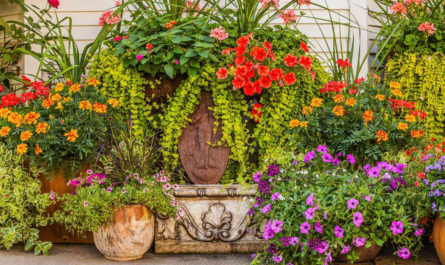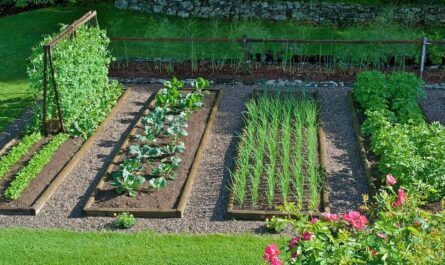It can be a satisfying task to design a gorgeous garden that thrives all year round. For gardeners who want low maintenance and regular blooms, perennial flowers are a great option. The top ten perennial flowers that can brighten your garden year-round with colour and charm are highlighted in this article. These flowers are ideal for both inexperienced and seasoned gardeners because they are not only aesthetically pleasing but also hardy and minimal maintenance.
1. Day-lilies (Hemerocallis) Perennial Flowers
Overview
Day lilies are a popular choice for perennial flowers because of their strong colour and hardiness. They are well-known for its trumpet-shaped flowers, which are available in pink, red, orange, yellow, and other hues.
Growing Conditions
Day lilies prefer full sun to partial shade and do best in well-drained soil. Once established, they can withstand drought and grow in a variety of soil types.
Maintenance
Day lilies need very little upkeep. Removing spent blooms by deadheading can promote new growth, and splitting the plants every few years helps keep them vigorous.
2. Cone-flowers (Echinacea) Perennial Flowers

Overview
Cone-flowers are distinguished by their cone-shaped centers and daisy-like look. They provide diversity to any garden because they are available in a variety of colours, including purple, pink, white, and yellow.
Growing Conditions
Full sun and well-drained soil are preferred by these blooms. They are perfect for summer gardening since they can tolerate heat and dryness.
Maintenance
Plants with coneflowers require little care. Dividing the clumps every few years will keep the plants healthy, and deadheading can extend the flowering season.
3. Hostas Perennial Flowers
Overview
Hostas come in a variety of green, blue, and gold hues and are highly appreciated for their rich foliage. On tall stalks, they have beautiful flowers that resemble bells.
Growing Conditions
Hostas prefer places that are shaded to partly shaded and have soil that is damp but well-drained. They are ideal for growing in shady garden nooks or beneath trees.
Maintenance
Hostas require very little upkeep. Watering on a regular basis is crucial, particularly during dry spells. Every few years, divide the clumps to help control their size and promote healthy growth.
4. Lavender (Lavandula)
Overview
Lavender is prized for its silvery-green leaves and fragrant purple blossoms. It draws pollinators like bees and butterflies to gardens in addition to being a lovely feature.
Growing Conditions
Lavender likes soil that drains well and full light. Because it can grow in rocky, sandy, or arid environments, it is ideal for places with inadequate soil.

Maintenance
Maintenance needs for lavender are minimal. After blooming, pruning promotes new growth and helps the plant keep its shape. Once established, lavender can withstand drought, so try not to over-water it.
5. Peonies (Paeonia)
Overview
Large, fragrant blossoms in a variety of colors, including pink, red, white, and yellow, are the hallmark of peonies. Because of their durable blossoms, they are a popular among gardeners.
Growing Conditions
Peonies prefer full sun to partial shade and well-drained soil. To shield their fragile blooms from harsh winds, they do best when planted in a sheltered spot.
Maintenance
Peonies need little maintenance. Stakes can be used to support the heavy flowers so they don’t droop. Fall foliage pruning aids in disease prevention.
6. Black-Eyed Susans (Rudbeckia)
Overview
Bright yellow daisy-like flowers with dark brown centers are called Black-Eyed Susans. They are resilient and can liven up any garden with a vibrant pop of colour.
Growing Conditions
These flowers do well in soil that drains well and full sun. They can thrive in a variety of soil types, including clay and sandy soils, and they are resistant to drought.
Maintenance
Black-Eyed Susans require little maintenance. Deadheading wasted flowers might help them to bloom continuously. Plants should be divided every few years to maintain their vigour.
7. Shasta Daisies (Leucanthemum x superbum)
Overview
Classic white Shasta Daisies with golden centers are known for their beauty. They are well-known for drawing pollinators and having a lengthy flowering season.
Growing Conditions
Shasta Daisies like soil that drains well and full light. They are adaptable garden plants since they can withstand a range of soil conditions.
Maintenance
Shasta Daisies need very little upkeep. Removing deadheads can encourage new blooms, and splitting up the clumps every few years can maintain plant health.
8. Bleeding Hearts (Dicentra)
Overview
The unusual flowers known as bleeding hearts have heart-shaped blossoms that hang on stalks that arch. They give gardens a whimsical touch and are available in pink, red, and white hues.
Growing Conditions
Bleeding Hearts prefer well-drained soil and shade, ranging from partial to full. They can withstand damp circumstances and prefer lower temperatures.
Maintenance
Bleeding Hearts require little upkeep. Diseases can be avoided by cutting down the foliage after blooming, and controlling the growth of the plants can be achieved by dividing them every few years.
9. Russian Sage (Perovskia atriplicifolia)
Overview
The fragrant silvery foliage and airy lavender-blue blossoms of Russian sage are well-known. It draws pollinators and gives gardens a delicate, ethereal feel.
Growing Conditions
This plant likes soil that drains well and full sun. It grows well in hot, arid climates and is resistant to drought.
Maintenance
Russian sage requires little maintenance. Early spring pruning promotes new growth, and once established, little watering is required.
10. Astilbes Perennial Flowers
Overview
Admired for their fluffy plumes of pink, red, white, and purple flowers, asters are known for their elegance. They provide gardens with shadows a hint of beauty.
Growing Conditions Perennial Flowers
Astilbes like moist, well-drained soil and medium to full shade. They look great planted in wooded gardens or beside to water features.
Maintenance
To keep the soil moist, astelias need to be watered often. Removing the blooms off the flower stalks can promote regrowth, and splitting the clumps every few years can keep them healthy.
Conclusion
By including these ten best perennial flowers in your garden, you can guarantee a bright and colorful scene all year round. These flowers are perfect for a variety of garden designs and situations because they each add a special beauty and characteristic to the table. You can have a low-maintenance landscape with constant flowers by combining a variety of these perennials. Cheers to your successful gardening!



